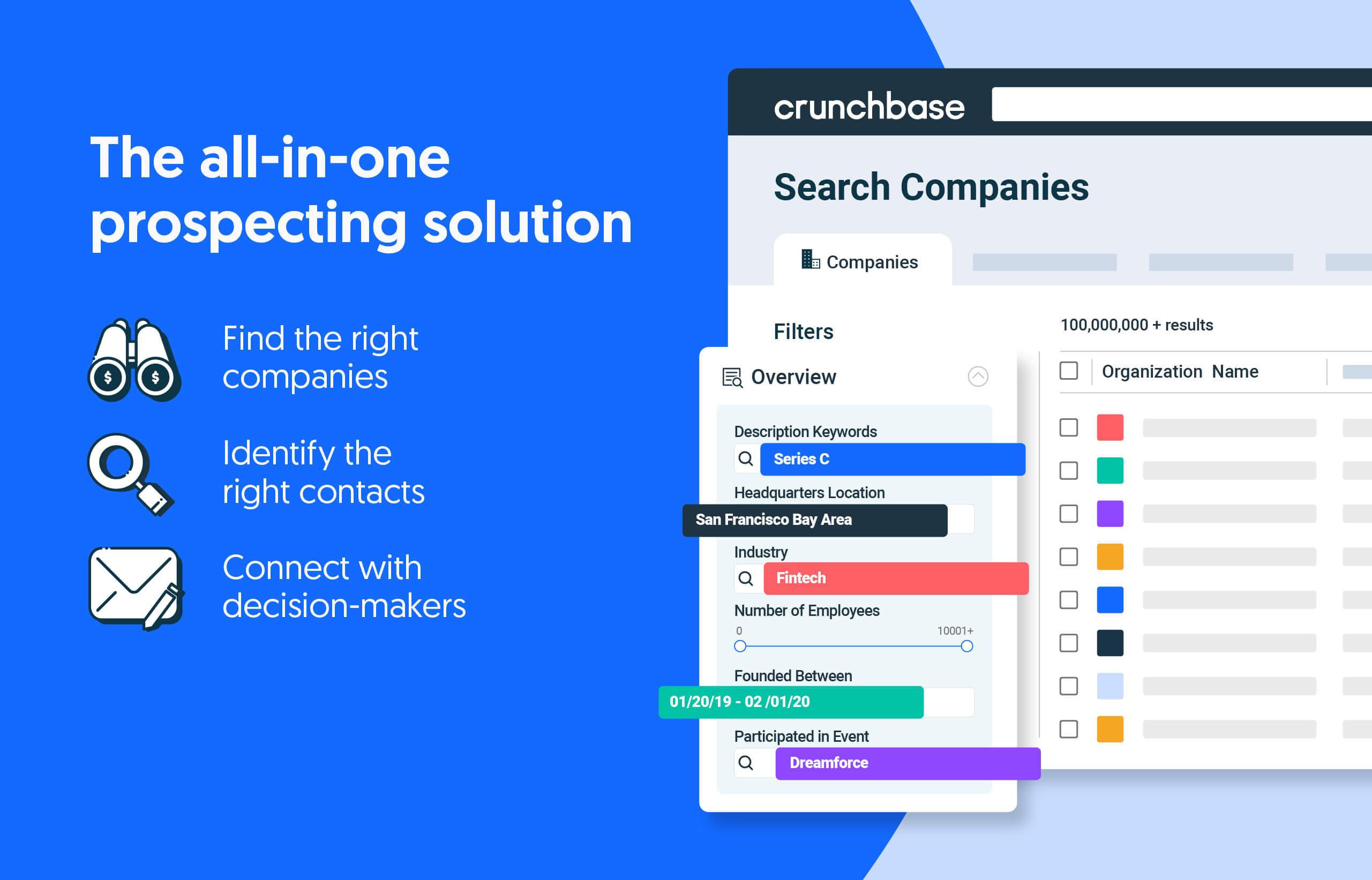B2B sales, or business to business sales, is the practice of selling products and services from one business to another.
To acquire a piece of the pie, implementing proper B2B sales techniques is crucial. But what is B2B sales on a deeper level, and how can you ensure you’re implementing the most effective B2B sales techniques? In this guide, we discuss what B2B sales is and how to refine your sales processes to win more deals.
Search less. Close more.
Grow your revenue with all-in-one prospecting solutions powered by the leader in private-company data.
What is B2B sales?
B2B sales, or business-to-business sales, involve transactions where a business sells products or services to another business. Unlike B2C (business-to-consumer) sales, B2B sales typically feature larger deals, a longer decision-making process involving multiple stakeholders, and buyers who are more informed and focused on business needs.
Types of B2B sales
Depending on the product and the type of business model adopted by the seller, there are three different B2B sales examples to account for. Let’s examine three different B2B sales models.
- Supply
A B2B seller operating a supply model will be responsible for selling consumables that support the business activities of another business. Examples could include employee workwear and personal protective equipment. The sales process used by these organizations will follow that of B2C companies.
The difference comes with the number of products sold and the purchase authorization process. Rather than purchasing new work overalls, an employee will order 100 overalls and will need to gain approval from a manager, or other authority within the company, before the purchase can go ahead.
- Wholesale
Wholesale B2B sellers are responsible for selling critical retail or manufacturing components to other businesses. Food distributors that serve restaurants are an example of these types of businesses. They sell their products at the wholesale rate, and then the buyer charges customers a marked-up price for the product.
- Service/Software
The only difference between service/software B2B sellers is they sell a service rather than a product. In many cases, these businesses operate entirely online with no physical products. Crunchbase is an example of a software company that offers a B2B sales prospecting solution that’s entirely online.
B2B sales vs. B2C sales
B2C sales are made directly to a consumer. They are typically much smaller in scale and involve no discussion between anyone other than the immediate consumer. Some examples of B2C sellers include restaurants, online jewelry sellers, and supermarkets. A B2B seller has no dealings with consumers. Instead, they speak directly to other companies.
What are the other key differences between the B2B sales cycle and the B2C sales cycle?
- Higher transaction value – B2B contracts have a higher average transaction value. It is not uncommon for these contracts to run into millions of dollars.
- B2B sales cycles are longer – Most B2C transactions are made on impulse to fulfill an immediate need. B2B buyers are looking for a strong ROI and often a service that will impact their bottom line, which means multiple decision-makers have a role in the process.
- Multiple stakeholders – A B2C buyer has one stakeholder, themselves. B2B buyers, on the other hand, typically require agreement from multiple parties to authorize the transaction.
- Educated buyers – The average business is extremely discerning about the products and services they buy. These buyers are typically highly educated and selective about who they do business with.
Due to these differences, B2B sales techniques will always differ from B2C sales techniques.
B2B sales process explained
The B2B sales cycle has never been more complex than it is now. Previously, a salesperson would seek out a suitable buyer, speak to the manager, and close the deal. Now, with so much competition and greater knowledge of sales strategies, the process has become more convoluted. Let’s walk through the B2B sales process.
Step 1: Do your research
B2B salespeople need to know every facet of their market, target customers and competitors. They must understand where their product or service fits into the existing marketplace. Good B2B sellers already know the value of their product and can explain how their solution uniquely solves critical business pain points in a number of ways.
Step 2: Find your ideal customer
Your ideal customer is defined both by organization-level firmographics and the decision-maker within that organization. You need to make sure that the person you’re speaking to has the authority to authorize a purchase. A strong assessment and qualification process for prospects is vital to avoid any wasted time. There is little purpose in speaking to an employee who loves the product, only to discover they don’t have any buying power or authority when it comes to purchasing decisions.
Step 3: Start your outreach
There are several ways to begin your initial prospecting and outreach. Inbound marketing techniques that are designed to attract people to your site, such as creating a company blog, are just one option. Alternatively, many companies also employ outbound prospecting strategies like cold calling. The point of this outreach is to initiate contact with a key decision-maker and gauge their interest.
Step 4: Make a pitch
Half the battle for B2B salespeople is getting the opportunity to pitch their value proposition in the first place. If you have the opportunity to speak directly with a prospect, ensure you perfect that pitch and explain how your product or service can solve a prospect’s problems and deliver a positive ROI. The most important thing to remember is that all pitches must be tailored to the individual prospect.
Step 5: Follow up with your leads
Following up keeps the relationship alive and helps move leads and prospects down the sales funnel. Remember, the average business receives sales pitches on a daily basis. B2B salespeople need to ensure they stay top of mind with their leads and prospects so they don’t get lost in the mix. One tactic for an immediate good impression after a pitch is to deliver a statement of work that provides the content of the meeting in writing.
Step 6: Close the deal
Regardless of which B2B sales models are in operation, closing the deal is the sixth and final step. Once the client has authorized the transaction in writing, the sale has been successfully closed. This can often be the hardest step. A hesitant client may need some extra encouragement in the form of another meeting or a free product demo.
B2B sales examples
The simplest way to understand B2B sales intelligence is to look at how it works in action. Here are some examples that demonstrate the B2B process.
Lyreco
Lyreco is a B2B seller of office and equipment supplies. This national brand has permanent contracts with countless businesses to provide them with all the office equipment and supplies they need. Examples of some of the products they sell include stationery, printer cartridges and office furniture. Lyreco is an example of supply B2B sales.
JJ Foodservice
JJ Foodservice is one of the leading names within the wholesale food distribution industry. It sells directly to fast-food outlets and restaurants exclusively. These buyers then mark up the food and sell it to consumers. This is a great example of wholesale B2B sales.
TurboTax
TurboTax is one of the top two providers of tax accounting software in the U.S. While it is something of a hybrid in that it does sell software to individual consumers for personal use, most of its revenue comes from helping businesses keep their taxes in order. TurboTax is an example of a service-based B2B seller.
B2B sales tips & techniques
There’s an entire industry based on providing B2B sales tips and strategies to salespeople looking to break into the B2B world. This industry is permanently evolving, and staying on top of the latest strategies is the foundation to long-term success. Let’s examine some of the best techniques to improve your B2B sales process.
1. Use customer relationship management (CRM) software
CRM software is key to tracking prospects, noting where they are in your sales funnel, and building better relationships. Some examples of the most popular CRM software options include Salesforce, HubSpot and Zoho. You can even streamline your workflow by integrating your CRM with the tools you use to prospect.
2. Focus on solutions
Take the time to dive into your lead’s business to try and understand the company as much as they do. This requires a firm grasp of their challenges and what they want to achieve, which is especially challenging because leads are not always forthcoming about their difficulties. It’s up to the salesperson to uncover relevant problems and identify how their solutions can help.
3. Better customer targeting
B2B selling is a numbers game, but simply reaching out to everyone hoping that someone will make a purchase is neither good from a time perspective nor a reputational perspective. After all, the process of doing business does not end upon closing the sale. Selling the wrong product to the wrong business will only lead to a negative customer experience. Utilize tools like Crunchbase to discover companies that match your ideal target prospects.
Search less. Close more.
Grow your revenue with all-in-one prospecting solutions powered by the leader in private-company data.
4. Understand the long game
It can take months to progress from initial outreach to closing the sale. This is an area of sales that prioritizes relationships and builds trust between both parties. Take the time to develop these relationships and win happy clients who will want to sign contracts again and refer your product to their network.
5. Craft compelling content
Did you know that the average B2B buyer consumes 13 pieces of content before committing to a purchase? Winning hearts and minds through blogs, eBooks, white papers and infographics will transform your business and take it to the next level. B2B buyers often take months to decide on a vendor; engaging content can be the difference between a closed/won and closed/lost.
Find the right prospects with Crunchbase
B2B is a hypercompetitive sales landscape that requires a detailed understanding of your ideal customer and access to tools that allow you to easily find critical information so you can focus on the right prospects. Check out this list of sales tools to spruce up your sales arsenal in 2022 and learn more about how Crunchbase’s solutions can help streamline your prospecting.
.svg)








